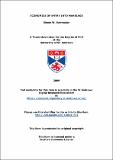Files in this item
Economics of entry into marriage
Item metadata
| dc.contributor.advisor | Smith, Ian | |
| dc.contributor.author | Bowmaker, Simon W. | |
| dc.coverage.spatial | 253 | en |
| dc.date.accessioned | 2009-06-26T14:06:37Z | |
| dc.date.available | 2009-06-26T14:06:37Z | |
| dc.date.issued | 2009-06-26 | |
| dc.identifier | uk.bl.ethos.552261 | |
| dc.identifier.uri | https://hdl.handle.net/10023/721 | |
| dc.description.abstract | This thesis contains three studies on the economics of entry into marriage; a life event that has been shown to have significant implications for the well-being (economic and otherwise) of men, women and their children. The first study examines the effect of family background on the timing of first marriage of 7,853 individuals born in 1970 in Great Britain. Hazard model analysis reveals that high levels of parental resources serve to delay entry into marriage for both males and females, although this effect fades as a young adult ages. Consistent with theories of “resource dilution”, a greater number of siblings present in the household during adolescence is associated with early marriage for both sexes. It is also found that the presence of a younger sibling in the household hastens marriage for males, while the presence of a younger brother is associated with early marriage for both sexes. The second study investigates how changes in abortion policy in Eastern Europe during the late-eighties and early-nineties may have affected female first-marriage rates. Previous studies have suggested that more liberal abortion laws should lead to a decrease in marriage rates among young women as ‘shotgun weddings’ are no longer necessary. Empirical evidence from the United States lends support to that hypothesis. This study presents an alternative theory of abortion access and marriage based on the cost of search that suggests that more liberal abortion laws may actually promote young marriage. An empirical examination of marriage data from Eastern Europe shows that countries that liberalized their abortion laws during the late-eighties and early-nineties saw an increase in marriage rates among non-teenage women. The third study uses a unique and comprehensive panel of 2441 U.S. counties spanning from 1970 to 1999 to examine the relationship between the cost of owner-occupied housing and entry into marriage. It is found that the burden of housing costs negatively affects the marriage rate. Further, it is reported that the greater the difference between the annual cost of owning a house and the annual cost of renting, the lower the marriage rate. These are important findings since they imply that government policies designed to reduce the cost of housing (such as tax advantages to owner-occupiers) have the potential to encourage entry into marriage. | en |
| dc.format.extent | 1518412 bytes | |
| dc.format.mimetype | application/pdf | |
| dc.language.iso | en | en |
| dc.publisher | University of St Andrews | |
| dc.rights | Creative Commons Attribution 3.0 Unported | |
| dc.rights.uri | http://creativecommons.org/licenses/by/3.0/ | |
| dc.subject | Economics | en |
| dc.subject | Marriage | en |
| dc.title | Economics of entry into marriage | en |
| dc.type | Thesis | en |
| dc.type.qualificationlevel | Doctoral | en |
| dc.type.qualificationname | PhD Doctor of Philosophy | en |
| dc.publisher.institution | The University of St Andrews | en |
This item appears in the following Collection(s)
Except where otherwise noted within the work, this item's licence for re-use is described as Creative Commons Attribution 3.0 Unported
Items in the St Andrews Research Repository are protected by copyright, with all rights reserved, unless otherwise indicated.


